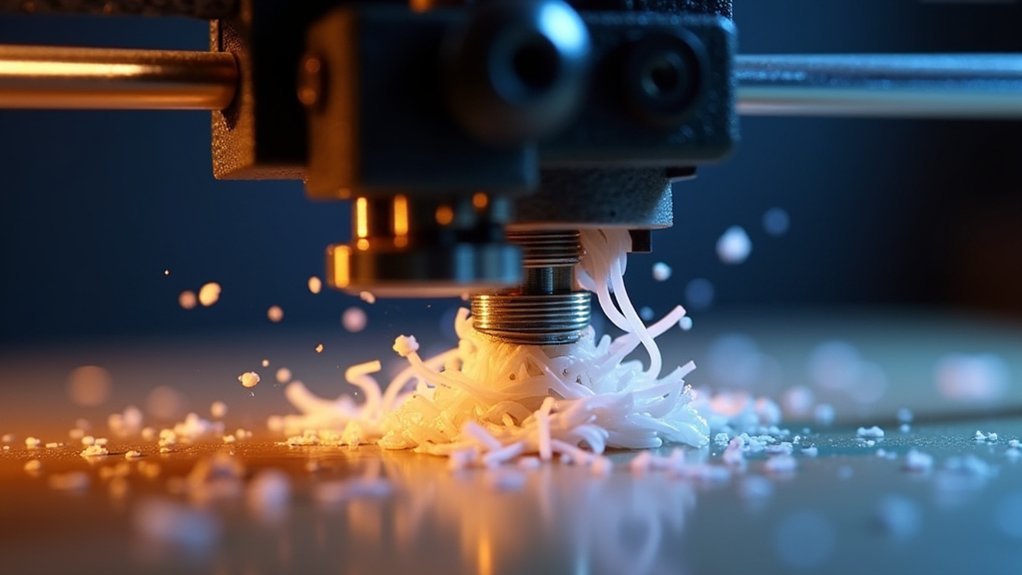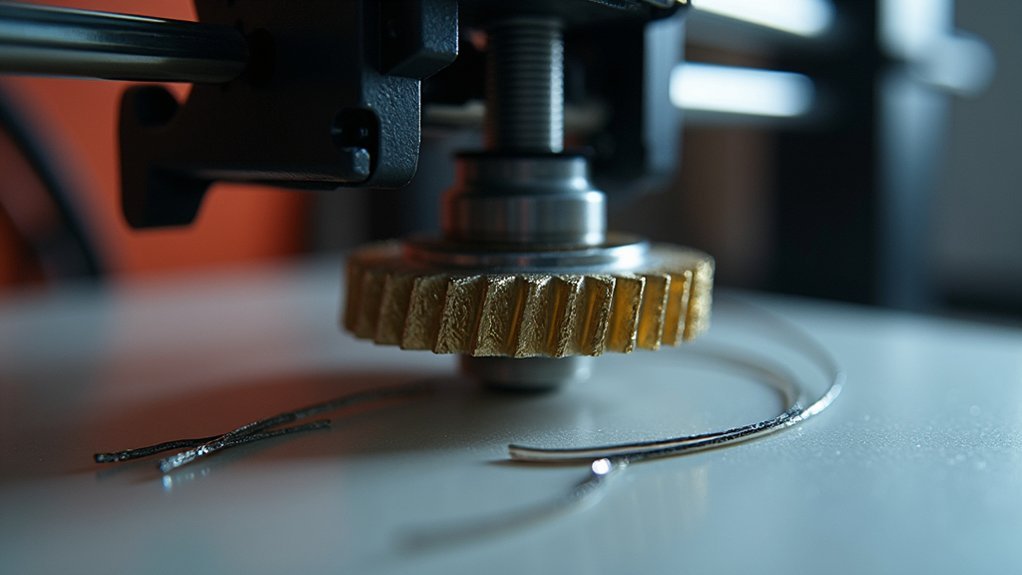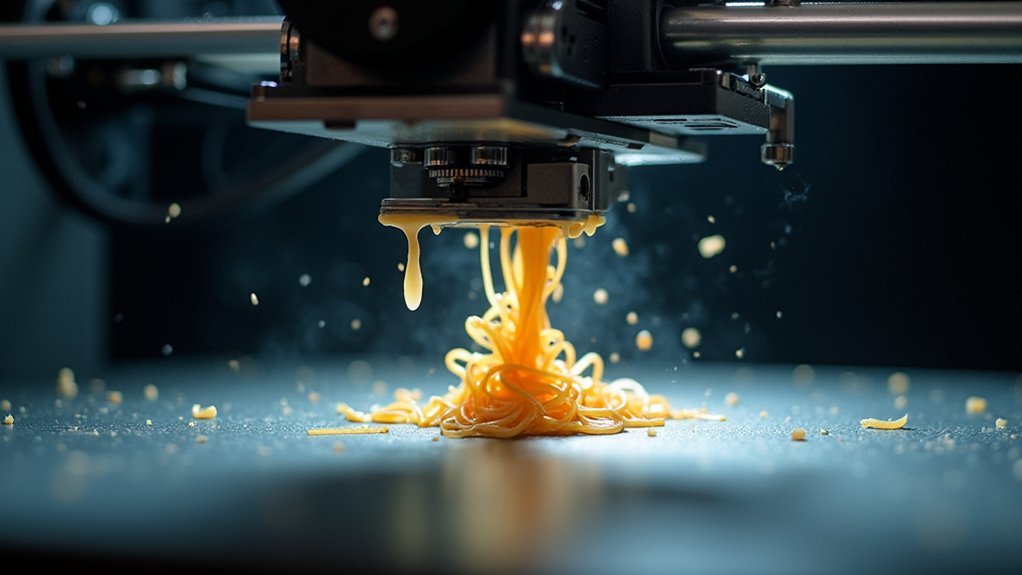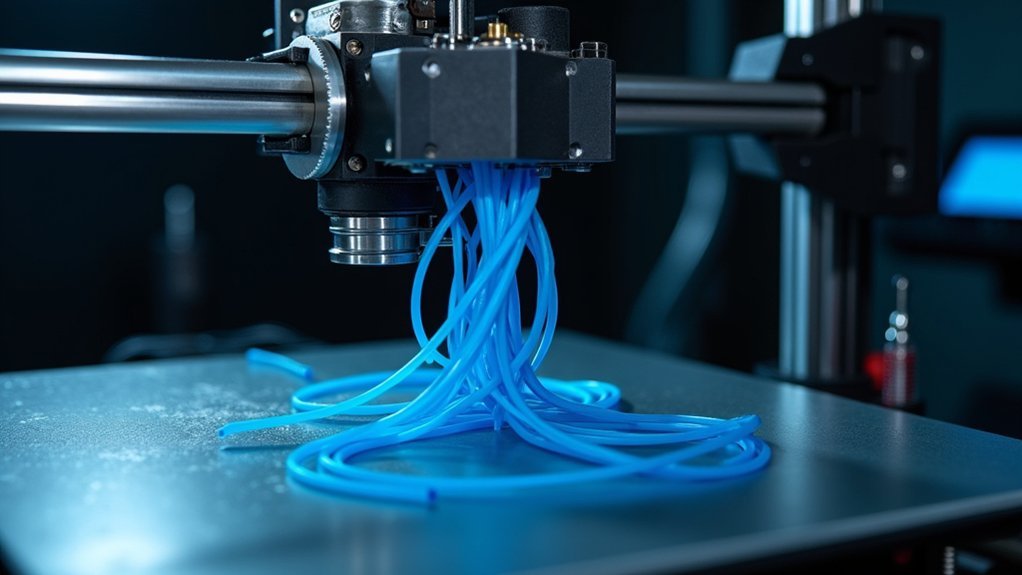Your 3D printer’s extruder won’t feed filament due to several common issues: clogged nozzles blocking material flow, improper drive gear tension causing slipping or grinding, worn PTFE tubes creating friction, tangled filament on the spool, or sensor malfunctions triggering error codes. Temperature settings below 170°C can cause heat creep, while debris accumulation in the hot end creates obstructions. Check for clicking sounds, blinking indicator lights, and lack of teeth marks on filament to identify the root cause and restore proper feeding performance.
Signs Your Extruder Has Feeding Problems

When your 3D printer’s extruder starts malfunctioning, you’ll notice several telltale signs that indicate feeding problems. A blinking red light on your AMS signals potential filament feeding issues, often paired with clogs or extruder malfunctions.
You’ll hear intermittent clicking or grinding noises during feeding, indicating inadequate grip or blockages within the extruder. If filament reaches the extruder entrance but won’t pass through, there’s likely an obstruction or improper alignment in the feed path.
Check your spool regularly for tangled filament, as this greatly impedes feeding and causes extrusion failures. When you pull filament from the extruder and see no teeth marks, your drive gear isn’t gripping properly, suggesting mechanical or calibration issues.
Clogged Nozzle and Heat Break Issues
You’ll encounter two main obstruction points in your extruder: the nozzle tip and the heat break area.
When debris accumulates or prolonged heat exposure causes material buildup, these blockages prevent filament from flowing properly through your system.
Identifying which component is clogged requires understanding the specific symptoms each location produces during failed extrusion attempts.
Identifying Nozzle Blockages
Although your 3D printer’s extruder motor continues running, a clogged nozzle will prevent filament from flowing properly onto the print bed.
You’ll notice several telltale signs that indicate blockage issues. Listen for clicking or grinding noises from your extruder motor as it struggles to push filament through the obstruction.
Watch for irregular extrusion patterns where filament comes out inconsistently or stops completely mid-print. You’ll also find that manually feeding filament becomes difficult or impossible beyond a certain point in the pathway.
Check if your filament can’t advance past the heat break area, where swelling often occurs.
These symptoms typically worsen as debris accumulates or when prolonged high temperatures soften filament outside the designated melt zone, creating persistent blockages.
Heat Break Clogs
Two critical areas where blockages commonly develop are the nozzle tip and the heat break section above it. Heat break clogs occur when filament softens prematurely outside the melt zone, preventing proper extrusion. You’ll notice delayed or insufficient filament flow during initial layers when this happens.
| Issue | Cause | Solution |
|---|---|---|
| Premature softening | Heat creep | Check cooling fan |
| Debris accumulation | Poor maintenance | Regular cleaning |
| Temperature problems | Incorrect settings | Verify filament specs |
| Persistent clogs | Internal blockage | Disassemble hotend |
| Flow inconsistency | Partial obstruction | Use cleaning tools |
Regular inspection and cleaning prevent debris accumulation. Verify your extruder temperature exceeds the filament’s melting point. For persistent heat break clogs, use specialized cleaning tools or completely disassemble the hotend for thorough inspection and maintenance.
Drive Gear Tension and Filament Stripping

Proper drive gear tension sits at the heart of reliable filament feeding, requiring a delicate balance that prevents both slipping and stripping. When you set the tension too loose, your filament will slip through the drive gear without advancing properly.
Conversely, excessive tension causes the gear’s teeth to bite too deeply into the filament, creating visible plastic shavings and compromising the material’s integrity.
Excessive tension damages filament by causing drive gear teeth to bite too deeply, creating plastic shavings and material degradation.
You’ll need to adjust your extruder’s tension screws carefully, finding the sweet spot that allows smooth advancement without excessive pressure.
Regularly inspect your drive gear for wear and proper alignment, as misalignment creates inconsistent feeding. Listen for grinding sounds or skipping during operation—these indicate tension problems.
Document any issues you encounter to identify patterns and resolve feeding problems before they worsen.
PTFE Tube Wear and Replacement
Your PTFE tube’s condition directly impacts filament flow, so you’ll need to recognize signs of wear like rough inner surfaces, deformation, or visible scoring that can catch filament.
When damage appears, you must cut replacement tubes at a perfect 90° angle and chamfer the edges to prevent snagging during filament travel.
Test your tube’s integrity by threading fishing line through it – any resistance indicates it’s time for replacement.
Identifying Tube Damage
The PTFE tube serves as a critical pathway for filament delivery, and identifying damage early can save you hours of troubleshooting failed prints.
Start by examining your PTFE tube for visible holes, cracks, or worn spots that can catch filament and cause jams. Even minor imperfections will disrupt smooth filament flow.
Check both ends of the tube—they should be cut at perfect 90° angles with chamfered edges to prevent snagging.
Don’t overlook the connectors at each end; gaps can develop over time, compromising the feed path’s integrity.
If you notice any damage or wear, especially after extensive use, replace the tube immediately rather than attempting repairs that won’t restore proper function.
Proper Replacement Techniques
When replacing a damaged PTFE tube, you’ll need to carefully remove the old tube and prepare your replacement to exact specifications.
Follow these critical steps to guarantee peak performance:
- Cut at 90° angle – Use a sharp blade or PTFE cutter for clean, perpendicular cuts that prevent filament catching.
- Chamfer the edges – Smooth the tube openings to eliminate sharp corners that could snag filament during operation.
- Test before installation – Push filament through the new tube to verify there’s no obstruction or resistance.
- Consider upgrades – Add rub rings or print PTFE guides to enhance durability and extend tube lifespan.
These precise techniques guarantee your extruder can properly feed the filament without interruption or jamming issues.
Extruder Priming and Oozing Problems

Why does filament sometimes fail to extrude filament properly at the start of your print, leaving gaps or weak initial layers? The culprit is often improper extruder priming combined with oozing problems.
When your nozzle sits idle at high temperatures, filament naturally oozes out, creating voids in the hot end that cause delayed extrusion.
You can solve this by implementing effective priming techniques. Using a skirt in Simplify3D allows filament to flow consistently before your actual print begins.
Alternatively, manually extrude material through Jog Controls to guarantee readiness. Maintain proper extruder temperatures above 170°C for most filaments to prevent oozing while ensuring smooth flow.
Without proper priming, oozing can create blockages that compromise your print quality from the very first layer.
Nozzle Height and Bed Clearance
Most 3D printing failures stem from incorrect nozzle height, where positioning your extruder too close to the build platform blocks filament flow and ruins your print before it begins.
When your nozzle sits too low, there’s insufficient space for material to exit properly, creating a frustrating cycle of failed prints.
You’ll need to fine-tune your Z-axis settings to achieve ideal nozzle height:
- Adjust Z-offset incrementally in software like Simplify3D for precise clearance
- Check for blocked nozzle holes that prevent proper extrusion flow
- Monitor first layers for signs of inadequate material deposition
- Account for different filament types requiring specific height adjustments
Regular nozzle height calibration considerably improves print quality and prevents feeding issues throughout your printing process.
AMS and Automatic Feeding System Failures
When your AMS fails to feed filament properly, you’ll often encounter specific error codes that indicate whether the issue stems from filament identification problems or RFID tag malfunctions.
These feeding disruptions can profoundly impact your print quality and completion rates.
The most common culprits behind AMS failures are damaged PTFE tubes and error messages related to filament detection sensors.
Error Codes and Signs
Although 3D printer extruders can fail in various ways, specific error codes and visual indicators provide clear diagnostic clues for AMS-related problems.
When your system encounters feeding difficulties, you’ll notice distinct patterns that help identify the root cause.
Watch for these key indicators:
- Error code 0700 8006 142105 appears when filament reaches the extruder entrance but fails to pass through properly.
- Blinking red AMS light signals active feeding issues during operation.
- Filament rolling back after multiple unsuccessful feeding attempts, creating visible retraction.
- Cross-filament compatibility problems affecting even manufacturer-recommended materials like Bambu Labs products.
These symptoms often emerge together, creating a clear diagnostic picture.
The combination of specific error codes with visual cues like the red blinking light and filament back movement helps you quickly identify AMS-related extruder problems versus other mechanical issues.
PTFE Tube Problems
PTFE tube deterioration ranks among the primary culprits behind AMS feeding failures, creating a cascade of problems that’ll frustrate even experienced users.
PTFE tube wear and tear increases friction considerably, causing blockages that prevent proper filament feeding through your automatic material system.
You’ll need to inspect these tubes regularly since damaged or improperly cut sections obstruct filament flow notably.
Heat creep within the tube causes filament expansion, creating jams during material changes.
When cutting replacement tubes, verify they’re cut at a perfect 90° angle and chamfer the edges to prevent filament catching.
Clogs near the hotend particularly hinder extrusion, so you’ll want to check this area thoroughly.
Don’t overlook this maintenance—it’s crucial for maintaining consistent feeding performance.
Filament Path Obstructions and Tangles
Since filament path obstructions represent one of the most common causes of extruder feeding problems, you’ll want to systematically check your entire filament delivery system from spool to hotend.
Start by examining your filament spool for tangles or knots that prevent smooth unwinding. Next, inspect the entire path for residual material from previous filament types that could block flow.
Here’s your inspection checklist:
- Verify PTFE tube cuts – Confirm tubes are cut at perfect 90° angles and inserted completely.
- Check connector wear – Look for worn fittings that aren’t sitting flush.
- Remove residual material – Clean out leftover filament fragments from previous prints.
- Test filament movement – Manually feed filament to identify friction points.
Regular maintenance prevents most filament path obstructions before they disrupt your printing.
Temperature Settings and Heat Creep
When extruder temperatures drift outside ideal ranges, you’ll encounter feeding problems that often masquerade as mechanical issues.
Heat creep represents one of the most frustrating culprits—it occurs when heat travels up your filament path, softening material before it reaches the hot end. This premature softening creates clogs and prevents proper extrusion.
Your temperature settings must exceed 170°C for most filaments to guarantee adequate melting and flow. However, excessive heat causes filament expansion within the PTFE tube, creating resistance that blocks your extruder’s feeding mechanism.
Combat heat creep by verifying your cooling system functions properly and your heat break stays adequately cooled.
Regular cleaning of your hot end and heat break area prevents filament residue buildup that worsens these temperature-related issues.
Hardware Inspection and Maintenance
Beyond temperature control, mechanical components demand systematic inspection to maintain consistent extrusion performance.
Your extruder’s hardware requires regular maintenance to prevent filament feeding failures that disrupt print quality.
Focus on these critical inspection points:
- PTFE Tubes – Check for wear, tears, and internal damage that can obstruct filament flow.
- Connectors – Verify flush connections without gaps that disrupt the filament path.
- Filament Switch – Test functionality and replace worn components that hinder proper feeding.
- Testing Methods – Use fishing line and cotton wool techniques to detect blockages in tubes.
You can improve durability by printing PTFE guides or adding rub rings to reduce friction.
These modifications help maintain smooth filament movement through your extruder system, preventing costly print failures.
Sensor Malfunctions and Error Codes
While mechanical components handle the physical aspects of filament movement, your extruder’s electronic sensors monitor and control the feeding process through sophisticated detection systems. Sensor malfunctions can trigger error codes like 0700 8006 142105, indicating filament detection failures that prevent proper extruder engagement.
| Error Type | Cause | Solution |
|---|---|---|
| RFID Detection | AMS sensor can’t read filament tags | Inspect sensor connections |
| Filament Presence | Sensor fails to detect loaded material | Check for physical damage |
| Type Recognition | Wrong material identified | Verify firmware version |
These sensor malfunctions primarily affect Automatic Material System operations, where RFID recognition determines feeding parameters. Regular inspection of sensor connections prevents wear-related failures. If firmware updates cause detection issues, reverting to previous versions often resolves feeding problems.
Manual Feeding Tests and Diagnostics
After identifying potential sensor issues, manual feeding tests provide direct diagnostic information about your extruder’s mechanical performance.
These hands-on evaluations reveal problems that aren’t always apparent through visual inspection alone.
To conduct a thorough manual feeding test, follow these steps:
- Engage the extruder gear disengage lever and attempt feeding filament directly into the hotend without obstruction.
- Listen carefully for clicking or grinding noises during feeding, which indicate extruder tension or alignment issues.
- Verify temperature settings are above the filament’s melting point during testing.
- Inspect the complete filament path for resistance, friction, tangled spools, and confirm PTFE tubes are properly cut and secured.
This systematic approach helps isolate whether feeding problems stem from mechanical components or other system failures.
Preventive Measures for Smooth Operation
Since extruder problems often develop gradually through normal wear and tear, implementing a consistent maintenance routine prevents most feeding issues before they impact your prints.
These preventive measures for smooth operation start with regularly inspecting and replacing PTFE tubes, as extensive use causes significant wear that restricts filament flow.
Regular PTFE tube inspection and replacement prevents filament flow restrictions caused by normal wear from extensive printer use.
Keep your extruder housing clean to prevent dust accumulation that creates clogs and filament feeding issues.
Always cut PTFE tubes at perfect 90° angles and chamfer edges to prevent filament catching.
Check extruder tension screws periodically—loose screws create inadequate feeding performance.
Conduct routine friction tests on your filament feed path to identify obstructions before they affect print quality.
Consistent maintenance eliminates most extruder problems.
Frequently Asked Questions
Why Is My 3D Printer Extruder Not Grabbing Filament?
Your extruder likely isn’t grabbing filament because the tension screw needs tightening for better grip. Check if the extruder gear has proper pressure against the filament to create sufficient friction for feeding.
Why Isn’t My 3D Printer Feeding the Filament?
Your filament isn’t feeding because you’ve got a clogged nozzle, improper extruder temperature, worn drive gear teeth, or PTFE tube friction. Check each component systematically to identify the specific blockage.
Why Is My Extruder Not Pushing Filament During Print?
Your extruder won’t push filament during prints due to clogged nozzles, low temperatures below 170°C, incorrect nozzle height, worn drive gears, or loose PTFE tube connections requiring immediate inspection.
Why Won’t My Filament Load Into the Extruder?
Check if your PTFE tube’s fully inserted and undamaged. Verify there’s no filament tangle on the spool. Adjust your extruder tension screw properly and clear any clogs in the hotend or filament path.





Leave a Reply